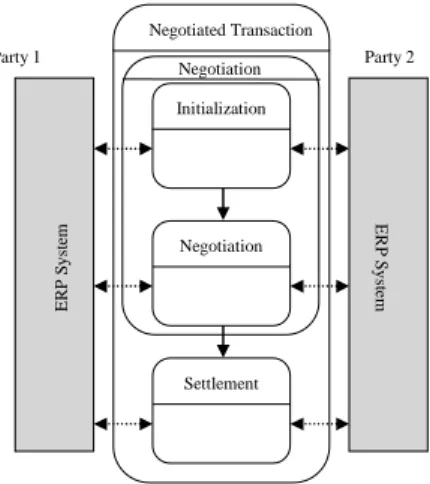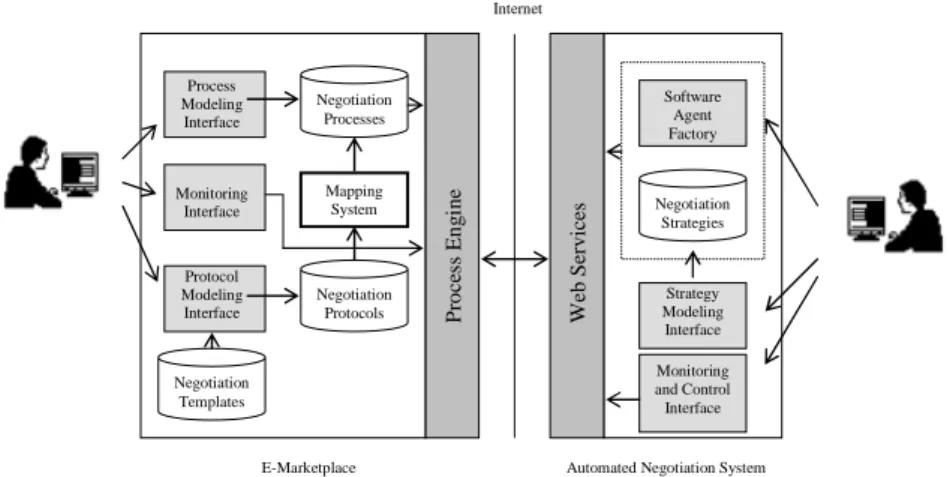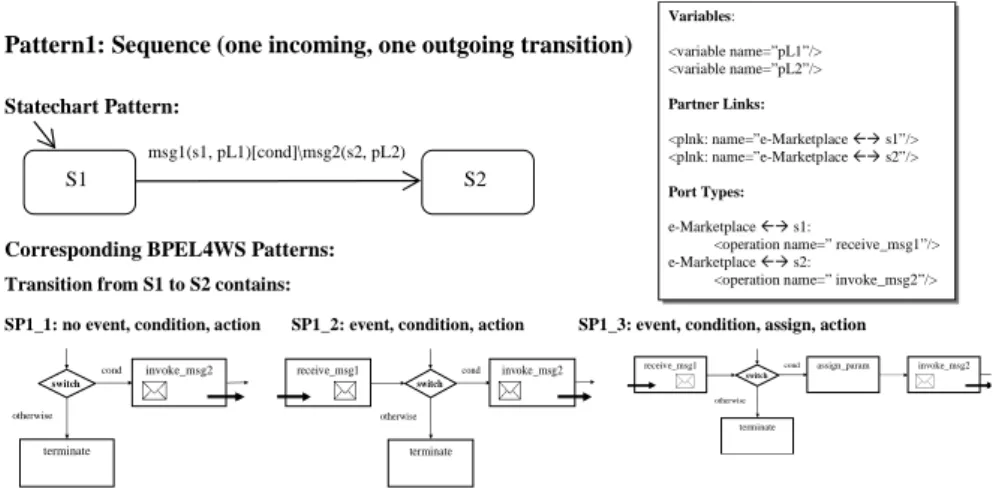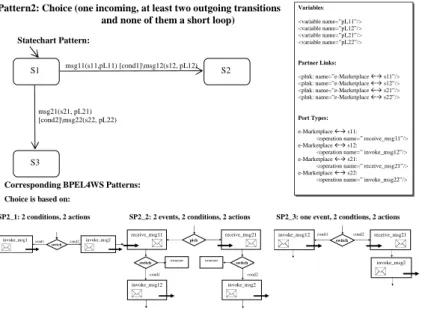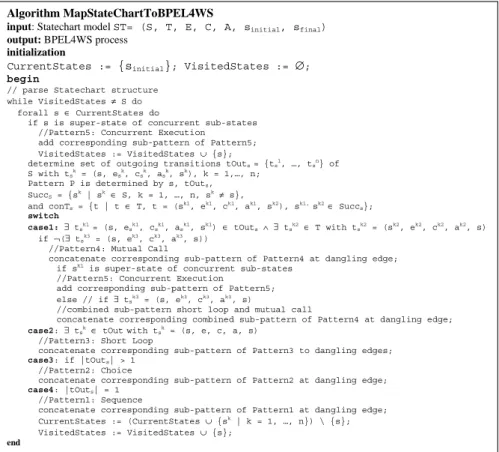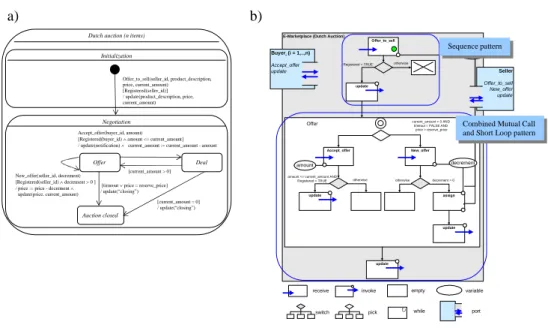A Model-Driven Approach for the Rapid Development of E-Negotiation Systems
1Morad Benyoucef and Stefanie Rinderle2 University of Ottawa
Ottawa, Ontario K1N 6N5, Canada
Abstract: Most of today’s e-marketplaces support a single negotiation protocol.
The protocol is usually built into the e-marketplace infrastructure, therefore if a new one is introduced then a time consuming and complex process of implementing it takes place. Moreover, participants in the e-marketplace need to adapt their interfaces to the new protocol, especially if they make use of automated means such as software agents to interact with the e-marketplace. This paper reports on a model-driven approach and a framework for rapid and user-friendly development of configurable e-marketplaces and automated e-negotiation systems.
A designer on the e-marketplace specifies negotiation protocols using Statecharts and feeds them to a mapping system that transforms them into web service orchestrations. Participants use automated negotiation systems to interact with the e-marketplace. An automated negotiation entity capable of interacting with the e- marketplace is generated based on the negotiation protocol implemented on the e- marketplace. The automated negotiation entity is provided with negotiation strategies and tactics specified in a declarative format. We propose a mapping algorithm to transform Statechart models of negotiation protocols into web service orchestrations.
1 Introduction
The Object Management Group (OMG) defines negotiation as “mechanisms that allow a recursive interaction between a principal and a respondent in the resolution of a good deal” [OMG99]. Usually, the principal and the respondent are a buyer and a seller who are set to negotiate the price, the delivery date, the conditions of the purchase, the terms of the guarantee, etc. The principal and the respondent can be individuals or organizations. Negotiation is vital in establishing business-to-business (B2B) relationships and, to a lesser extent, in facilitating consumer-to-consumer (C2C) commercial interactions. Indeed, a report by the Hurwitz Group claims that “80% of commerce is performed through negotiated trade” [Hur00]. Today, most of this negotiated trade takes place electronically, facilitated by e-commerce - i.e., the process of buying and selling goods and services electronically; and by e-business - i.e., the use of the Internet and information technology (IT) to execute all business processes in the enterprise, including e-commerce.
1 This work was conducted as part of a SSHRC funded project on E-Negotiations, Media, and Transactions for Socio-Economic Transactions
2 Stefanie Rinderle is from University of Ulm, Germany. This work was conducted during her post-doctoral stay at the University of Ottawa, Canada
Proc. Workshop on Enterprise Modelling and Information Systems Architectures (EMISA'05), Klagenfurt, Austria, October 2005
By integrating their IT infrastructures with those of their partners, traditional businesses are moving closer towards becoming real e-businesses. We believe that IT supported negotiation is a cornerstone in that integration. Electronic negotiation (e-negotiation) takes place when the negotiating function is performed through electronic means. We talk of fully automated e-negotiation when all parties involved are software agents, semi- automated e-negotiation when a human negotiates with a software agent, and manual e- negotiation when all parties are human [BSS96]. The interest in e-negotiation is motivated by its potential to provide business partners with more efficient processes, enabling them to arrive at more satisfying agreements in less time.
The most basic form of e-negotiation is the fixed price sale where an online seller offers goods or services at “take-it-or-leave-it” prices then buyers decide whether or not to make a purchase at the posted price. Auctions are a bit more complex and they are currently the most visible form of e-negotiation. Online auctions can reach a large and physically distributed audience at reduced cost, whereas offline auctions tend to cost more and require that the participants gather in one physical location. E-negotiations can take an even more complex form called bargaining. This involves making proposals and counter-proposals until an agreement is reached [San99]. Bargaining can be bilateral or multi-lateral, depending on whether there are two or more parties involved [OMG99]. If the object of the negotiation has more than one negotiable attribute (e.g., price, quality, and delivery date) then we talk of multi-attribute e-negotiations.
The negotiation process is manually intensive therefore using e-negotiation systems to automate it can reduce the costs associated with it [Hur00]. This is why the interest in designing these systems has focused on achieving higher efficiency and lower transaction costs [Mal87]. We distinguish three categories of e-negotiation systems [BKS03]: (1) negotiation support systems assist users with communication and decision- making activities; (2) negotiation software agents replace users in their communication and decision-making activities; and (3) e-negotiation media provide a platform that implements a negotiation protocol. There are two categories of e-negotiation media:
servers which implement multiple protocols, and applications which implement a single protocol. Traditionally, applications have dominated negotiation design, but lately, the importance of servers has increased, and a need for configurable servers is being felt [NBBV03]. Attempts were made to design configurable e-negotiation media to support more than one negotiation protocol. They were partially successful, but they were designed in an ad-hoc manner. Some of these attempts were: the AuctionBot [WWW98]
which supports the configuration of various auctions; GNP [BKL+00] which separates auction specifications from the logic of the server, and eAuctionHouse [Eau02] which allows for the configuration of auctions with the help of an expert system. Recently, Kersten et al. [KLS04] designed a configurable negotiation server that supports bargaining, based on a process model which organizes negotiation activities into phases;
and a set of rules that govern the processing, decision-making, and communication. The main problem in designing e-negotiation media is the lack of a systematic approach.
Indeed, to this day, design has been a trial-and-error process.
This paper presents a model-driven approach for rapid and user-friendly development of e-negotiation systems. We consider two categories of e-negotiation systems: “e- negotiation media” and “negotiation software agents”. We propose a new framework for configurable e-negotiation systems in which “e-negotiation media” is the electronic marketplace (e-marketplace) where human and software participants meet to negotiate deals. Automated negotiation systems provide a framework for the existence of
“negotiation software agents” and serve as the interface between the negotiator and the e-marketplace. The e-marketplace enforces negotiation protocols and therefore should make these protocols available for consultation and automation purposes. Separating the protocols from the e-negotiation media is a first step towards a configurable e- marketplace. Separating negotiation strategies from protocols also brings flexibility to the design of automated negotiation systems. Clearly, the design of e-marketplaces has a direct effect on the design of automated negotiation systems.
The first objective of this paper is to propose a service oriented framework for e- negotiation systems. The two main components of such framework are an e-marketplace and an automated negotiation system. The framework enables a designer on the e- marketplace to specify negotiation protocols and feed the resulting specification to a mapping system that transforms them into executable processes described using a web service (WS) orchestration language. The novelty here lies in the separation of the protocols from the e-negotiation media as well as in the mapping algorithm. Since no protocol exists that can fit the needs of all participants, the e-marketplace must be able to implement any new negotiation protocol with minimum time and effort. The automated negotiation system is also based on the separation of the negotiation protocols and strategies from the system. Based on the negotiation protocol implemented on the e- marketplace, an agent factory generates the component of the system that automates the exchange between the participant and the e-marketplace. A designer on the participant’s side can specify negotiation strategies using a declarative format. The second objective is to propose a mapping algorithm that transforms Statechart models of negotiation protocols into processes described using a WS orchestration language.
The paper is organized as follows: In Section 2 we discuss the use of Statecharts to specify negotiation protocols. In Section 3 we detail our service oriented e-negotiation framework. Section 4 describes the mapping of Statechart descriptions of negotiation protocols into processes described using a WS orchestration language. In Section 6 we discuss some related work, and in Section 7 we conclude and discuss the perspectives and future work.
2 A Generic Statechart Template for Business Transactions
Based on a requirements analysis for modeling e-negotiations, Statecharts [Hare87]
qualify as an adequate formalism. Statecharts have a good formal basis and can be serialized, visualized, and executed. They are well established, easy to understand, complete, and can be converted into other formalisms.
In [RiBe05] a requirements analysis for the suitability of Statecharts as formalism for modelling e-negotiation protocols as well as the Statechart models of five commonly used e-negotiation protocols are presented. This approach is extended in the current paper by introducing a mapping algorithm from the Statechart models to a web service orchestration language.
As shown in Fig. 1, a negotiated transaction between two or more parties usually goes through three distinct states. In the initialization state participating parties register on the e-marketplace which performs the necessary checks on the parties. The initialization can be as simple as signalling one party’s intent to participate in the transaction, in case the e-marketplace is set up for a closed circle of registered or invited members. If the e- marketplace is public, then the initialization can be as complex as one party completing rigorous registration procedures, and the e-marketplace performing the necessary verifications such as credit checks. If electronic links exist between the e-marketplace and the ERP systems of the participating parties, the initialization can be greatly facilitated by granting protected and restricted access to each other’s internal databases.
The negotiation state is where the parties negotiate by exchanging messages (offers, counter offers, etc.) according to the precise protocol of the negotiation implemented on the e-marketplace. A negotiating party can require an electronic link to its own ERP system to automatically check stock levels, manufacturing schedules, etc. The link makes it easier and quicker to respond to offers made by the other parties and to formulate counter offers. A successful negotiation leads to the drafting of a contract that needs to be executed by the agreeing parties. This is the settlement state. If a certain level of contract automation is achieved, then electronic links to the parties’ ERP systems are necessary to carry out certain transactions such as sending purchase orders, receiving payments, etc.
Negotiated Transaction
Initialization
Negotiation
Settlement
ERP System
ERP System
Party 2 Party 1
Negotiation
Figure 1: Generic Template for Business Transactions
3 Service-Oriented e-Negotiation Framework
Businesses are rapidly moving towards exposing their services on the web (giving way to WS), hoping to interact more efficiently with their partners and to achieve higher levels of automation at lower cost. For that reason our framework is based on a service oriented architecture (SOA). We believe that WS are appropriate for deploying e- negotiation systems because: (1) relationships between negotiating partners are dynamic;
(2) negotiation is part of procurement therefore interoperability between internal and external IT systems is important; and (3) WS provide a standardized and flexible integration technology that no organization can afford to ignore if it wants to interact with its partners [KiSe05]. Simply put, WS provide the means for software components to communicate with each other on the web using XML. A WS describes itself (using WSDL), can be located (using UDDI), and invoked (using SOAP).
It is important to remember that the e-marketplace is deployed by a negotiation facilitator (usually a third party) and its main role is to implement a negotiation protocol.
An automated negotiation system, on the other hand, is deployed by participants in the negotiation (i.e., negotiators). It can be seen as the interface between the negotiator’s internal IT systems (mainly the ERP system) and the e-marketplace. The framework presented in Figure 2can be interpreted as follows.
The e-marketplace: a designer on the e-marketplace side uses the Protocol Modeling Interface to design Negotiation Protocols. These protocols are usually represented using a formal specification such as Statecharts. The designer can also use Negotiation Templates available on the e-marketplace, and eventually modify them into negotiation protocols that answer the needs of the moment.
Internet
Negotiation Protocols Mapping System Negotiation
Processes
E-Marketplace
Negotiation Strategies
Automated Negotiation System Process
Modeling Interface
Monitoring Interface
Protocol Modeling Interface
Strategy Modeling Interface
Process Engine Web Services
Negotiation Templates
Monitoring and Control Interface Software Agent Factory
Figure 2: Service Oriented e-Negotiation Framework
The designer can choose to directly design the processes using a Process Modeling Interface which is a WS orchestration authoring tool. A Monitoring Interface will be used to monitor the execution of the negotiation process. The engine runs the process.
The Automated Negotiation System: In manual or automated negotiation, we have to distinguish between negotiation protocols which are the rules of the game (e.g., how the exchange of offers and counter offers takes place between the participants) and the negotiation strategies which are used by the participants to maximize their benefit (and to minimize their loss). Negotiation tactics are the small steps taken by participants towards achieving their strategies. Protocols are made public to every participant, but strategies and tactics are kept secret. However, nothing keeps a participant from trying to discover its opponent’s strategies and tactics by observing the opponent’s present and past behavior. In the framework of Figure 2 a designer on the participant’s side uses a Strategy Modeling Interface to design Negotiation Strategies. Based on the negotiation protocol implemented on the e-marketplace, a Software Agent Factory generates the components of the system that automates the exchange mechanism between the participant and the e-marketplace. A Monitoring and Control Interface is used to monitor and control the behavior of the automated negotiation system. The WS component groups all the interactions of the Automated Negotiation System and makes them available in the form of WS.
4 On Mapping Negotiation Protocols to Web Service Orchestrations
In this section we provide an algorithm for mapping Statechart models of e-negotiation protocols to processes described within a WS orchestration language.
4.1 Statecharts and Web Service Orchestration Language (BPEL4WS)
One particularity of our service oriented e-negotiation framework is the fact that it is based on the separation of negotiation protocols from the e-negotiation media (i.e., the implementation of the e-marketplace). This separation is achieved by using Statecharts to specify the protocols. Based on [JaSu04] we define a Statechart as a tuple ST= (S, T, E, C, A, sinitial, sfinal) where
• S is a finite set of states, E is a finite set of events, C is a finite set of conditions, and A is a finite set of actions
• T ⊆ S × E × C × 2A× S is a finite set of transitions where 2A denotes the power set of A
• sinitial∈ S is the (unique) initial state (i.e., sinitial has no incoming transitions)
• sfinal∈S is a final state (sfinal has no outgoing transitions)
From different case studies we derived several assumptions which hold for the Statechart models of e-negotiation protocols. Firstly, the event and action parts of the transitions comprise message sending and receiving events, i.e., the e-marketplace either waits for an incoming message sent by one of the participants or the e-marketplace itself sends a
message to one or more of the participants3. Secondly, we assume that the Statechart models are hierarchically decomposed (i.e., except for concurrent flow super-states there are no hierarchical states). For example, super-state Negotiation (cf. Figure 6a) can be decomposed and removed without losing basic information. As mentioned, one exception is the use of concurrent execution where sub-states may be ordered in parallel but must not be hierarchically decomposed themselves. Thirdly, the use of cyclic structures is restricted to loops with length less than three (i.e., only short loops of length one and mutual calls between two states of length two are allowed). The above assumptions can be formalized as follows:
Let EType be the set of all possible event types and let AType be the set of all possible action types. Let further eType: E Æ EType be the function which maps events to their specific event type and aType: A Æ AType the function which maps actions to their specific action types. Then:
o ∀ e ∈ E: eType(e) = msg_receiving
o ∀ e ∈ E: e = rec_message(sender, [paramList]) where sender is one of the e-marketplace participants
o ∀ a ∈ A: aType(a) ∈ {msg_sending, assign_values}
o ∀ a ∈ A with aType(a) = msg_sending:
a = send_id(sender, [paramList]) where sender is one of the participants of the e- marketplace
o no loops with lengths > 2: Let ST = (S, T, E, C, A, i, f) and ST’ = (S, T’, E, C, A, i, f) be Statecharts where ST’ is obtained by reducing transition set T of ST in the following way:
- if ∃ s ∈ S with ∃ (s, e, c, a, s) ∈ T: T’ := T \ {(s, e, c, a, s)}
- if ∃ s, s’ ∈ S with ∃ (s, e, c, a, s’), (s’, e’, c’, a’, s) ∈ T: T’ := T \ {(s’, e’, c’, a’, s)}
Then ST’ has to be acyclic.
o ST is hierarchically decomposed except for concurrent execution
o Concurrent execution contains no hierarchically decomposed sub-states∃ e ∈ E:
eType(e) = msg_receiving with ∃ T = (i, e, c, a, s), i.e., there is a transition condition containing a message receiving event4
As a WS orchestration language we use a subset of BPEL4WS. Within this paper a BPEL4WS process P is defined as a tuple P = (A, AT, S, ST, V, VL, PT, PL, i) where
• A is the set of simple activities and S is the set of structured activities
• AT is the function which assigns to each simple activity its particular type, i.e.:
AT: A → {<assign>, <empty>, <terminate>, <receive>, <invoke>, <pick>}
• ST is the function which assigns to each structured activity its particular type, i.e.: ST: S Æ {<sequence> … </sequence>, <switch> … </switch>,
<flow> … </flow>, <while> … </while>}
• V is the set of variables and VL ⊆ (A × V) ∪ (V × A) is the set of read / write accesses linking activities to variables and vice versa
• PT is the set of port types and PL is the set of partner links
• i is the initial state of P
3 In addition, the action part of a transition may include the assignment of process variable values.
4 This is important in order to generate the first receive activity within the process that drives the e- marketplace which initiates a new process instance.
4.2 Pattern-wise Mapping
In general, finding a complete mapping from Statecharts to a WS orchestration language such as BPEL4WS is a difficult task. Some approaches face this challenge in order to provide a model-driven development of WS [BBCT04, BDS05]. However, these approaches are based on some restrictions and assumptions (e.g., restricting transitions conditions to the conditional part). In our approach we start from a different direction by exploiting the assumptions which result from the specificity of Statechart models of e- negotiation protocols (cf. Section 4.1). Furthermore, we exploit the idea of identifying commonly used patterns within the Statechart models (comparable to workflow patterns in the process management domain [AHKB03]). For these commonly used Statechart patterns the corresponding BPEL4WS patterns have been elaborated. In the following we present and describe a selection of important patterns (for a more detailed description on the pattern-wise mapping refer to [BeRi05]). We provide an algorithm that constructs the complete BPEL4WS process based on these patterns in Section 4.3.
Figure 3 depicts the Statechart pattern for a sequence of states S1 and S2 connected by transition (S1, msg1(s1, pL1), cond1, msg2(s2, pL2), S2). The associated BPEL4WS pattern is shown as sub-pattern SP1_2: the e-marketplace waits for receiving message msg1 from sender s1. If msg1 is received and condition cond1 is true then the e- marketplace invokes the associated operation within the port type connected with sender s2 by sending message msg2. The parameter lists of messages msg1 and msg2 constitute the variables of the e-Marketplace. Note that a more precise definition of the variables is conceivable by splitting the parameter lists into single parameters and specifying the associated variables of the e-marketplace. The data flow is specified within the implementation of the receive and invoke operations (e.g., operation invoke_msg2 has input variable pL1 and output variable pL2). There may also be variations like sub- pattern SP1_1 (cf. Figure 3) depending on whether the event or the condition part of transition (S1, msg1(s1, pL1), cond1, msg2(s2, pL2), S2) is specified or not. Sub-pattern SP1_3 reflects the case where, within the action part of the transition, not only a message is sent but also a certain value is assigned to a particular process variable.
S1 S2
msg1(s1, pL1)[cond]\msg2(s2, pL2) Statechart Pattern:
Corresponding BPEL4WS Patterns:
Transition from S1 to S2 contains:
Pattern1: Sequence (one incoming, one outgoing transition)
Variables:
<variable name=”pL1”/>
<variable name=”pL2”/>
Partner Links:
<plnk: name=”e-Marketplace ÅÆ s1”/>
<plnk: name=”e-Marketplace ÅÆ s2”/>
Port Types:
e-Marketplace ÅÆ s1:
<operation name=” receive_msg1”/>
e-Marketplace ÅÆ s2:
<operation name=” invoke_msg2”/>
SP1_2: event, condition, action SP1_3: event, condition, assign, action SP1_1: no event, condition, action
switch
invoke_msg2
cond
terminate otherwise
receive_msg1 switch
invoke_msg2
cond
terminate otherwise
receive_msg1 switch
invoke_msg2
cond
terminate otherwise
assign_param
Figure 3: Sequence with Different Sub-Patterns
When mapping a Choice Statechart pattern (i.e., transitions from one to different other states are possible) the resulting BPEL4WS process pattern depends on whether the choice is based on different conditions (then the corresponding BPEL4WS process is a switch construct) or if it is triggered by different incoming messages (then a pick construct is used instead, cf. Figure 4).
These simple patterns give an idea of the principle of a pattern-wise mapping between Statecharts and BPEL4WS. In [BeRi05] mappings for more complex patterns are introduced: Pattern 3 (Short Loop) for loops of length 1, Pattern 4 (Mutual Call) for loops of length 2, and Pattern 5 (Concurrent Flow) for states which are ordered in parallel. Note that we do not claim completeness of our mapping approach. Our aim it to present a practicable approach for the model-driven development of e-negotiation processes.
4.3 Mapping Algorithm
Starting from the initial state the algorithm analyzes the Statechart patterns by traversing the Statechart graph and maps them to the associated BPEL4WS patterns as described in Section 4.2 and [BeRi05]. A Statechart pattern is determined by the currently analyzed state, its outgoing transitions, and its direct successor states.
S1 msg11(s11,pL11) [cond1]\msg12(s12, pL12) S2 Statechart Pattern:
Corresponding BPEL4WS Patterns:
Choice is based on:
Pattern2: Choice (one incoming, at least two outgoing transitions and none of them a short loop)
S3 msg21(s21, pL21) [cond2]\msg22(s22, pL22)
Variables:
<variable name=”pL11”/>
<variable name=”pL12”/>
<variable name=”pL21”/>
<variable name=”pL22”/>
Partner Links:
<plnk: name=”e-Marketplace ÅÆ s11”/>
<plnk: name=”e-Marketplace ÅÆ s12”/>
<plnk: name=”e-Marketplace ÅÆ s21”/>
<plnk: name=”e-Marketplace ÅÆ s22”/>
Port Types:
e-Marketplace ÅÆ s11:
<operation name=” receive_msg11”/>
e-Marketplace ÅÆ s12:
<operation name=” invoke_msg12”/>
e-Marketplace ÅÆ s21:
<operation name=” receive_msg21”/>
e-Marketplace ÅÆ s22:
<operation name=” invoke_msg22”/>
SP2_2: 2 events, 2 conditions, 2 actions SP2_1: 2 conditions, 2 actions
invoke_msg1
switch invoke_msg2
cond2
cond1
invoke_msg2
receive_msg11
pick
receive_msg21
cond2 cond1
switch terminate terminate switch
invoke_msg12
SP2_3: one event, 2 condtions, 2 actions
invoke_msg2
switch
receive_msg21 invoke_msg12
cond1 cond2
Figure 4: Choice with Different Sub-Patterns
We start with the pattern Mutual Call which may be also combined with a Short Loop pattern [BeRi05]. If the current pattern is neither a Mutual Call nor a Short Loop we check the number of outgoing edges. One outgoing edge indicates the Sequence pattern, more than one outgoing edge leads to the Choice pattern. Already “visited” states are stored within the set VisitedStates. The states to be analyzed next are determined as the direct successors of the currently treated state (set CurrentStates). The sets of variables, partner links, and port types can be determined by merging the corresponding sets of the particular patterns.
As an example we apply the mapping algorithm to the Statechart model of the Dutch auction protocol [RiBe05] as depicted in Figure 6a resulting in the BPEL4WS process depicted in Figure 6b.
Algorithm MapStateChartToBPEL4WS
input: Statechart model ST= (S, T, E, C, A, sinitial, sfinal) output: BPEL4WS process
initialization
CurrentStates := {sinitial}; VisitedStates := ∅; begin
// parse Statechart structure while VisitedStates ≠ S do forall s ∈ CurrentStates do
if s is super-state of concurrent sub-states //Pattern5: Concurrent Execution
add corresponding sub-pattern of Pattern5;
VisitedStates := VisitedStates ∪ {s};
determine set of outgoing transitions tOuts = {ts 1, …, ts
n} of S with tsk = (s, esk, csk, ask, sk), k = 1,…, n;
Pattern P is determined by s, tOuts, SuccS = {sk | sk ∈ S, k = 1, …, n, sk ≠ s},
and conTs = {t | t ∈ T, t = (sk1, ek1, ck1, ak1, sk2), sk1, sk2 ∈ Succs};
switch case1: ∃ ts
k1 = (s, es k1, cs
k1, as
k1, sk1) ∈ tOuts ∧ ∃ ts
k2 ∈ T with ts
k2 = (sk2, ek2, ck2, ak2, s) if ¬(∃ ts
k3 = (s, ek3, ck3, ak3, s)) //Pattern4: Mutual Call
concatenate corresponding sub-pattern of Pattern4 at dangling edge;
if sk1 is super-state of concurrent sub-states //Pattern5: Concurrent Execution
add corresponding sub-pattern of Pattern5;
else // if ∃ tsk3 = (s, ek3, ck3, ak3, s)
//combined sub-pattern short loop and mutual call
concatenate corresponding combined sub-pattern of Pattern4 at dangling edge;
case2: ∃ tsk ∈ tOutwith tsk = (s, e, c, a, s) //Pattern3: Short Loop
concatenate corresponding sub-pattern of Pattern3 to dangling edges;
case3: if |tOuts| > 1 //Pattern2: Choice
concatenate corresponding sub-pattern of Pattern2 at dangling edge;
case4: |tOuts| = 1 //Pattern1: Sequence
concatenate corresponding sub-pattern of Pattern1 at dangling edge;
CurrentStates := (CurrentStates ∪ {sk | k = 1, …, n}) \ {s};
VisitedStates := VisitedStates ∪ {s};
end
Figure 5: Mapping Algorithm
Starting with the outgoing transition of the initial state, the first pattern to be inserted is the Sequence pattern (cf. Figure 6b). The parameter list of the incoming message Offer_to_sell is described by the variable offer. The partner links comprise links to the seller and the buyers. The port types turn out as a receive Offer_to_sell operation within the partner link for the seller and an invoke of an update operation within the partner links of the seller and the buyers. The next state to analyze is Offer. The associated pattern comprises the set of outgoing transitions tOuts = {(Offer, …, Offer), (Offer, …, Deal), and (Offer, …, Auction Closed)}, the set of direct successor states Succs= {Deal, Auction Closed}, and conTs = {Deal, …, Auction Closed} and corresponds to the combined (Mutual Call, Short Loop) sub-pattern [BeRi05]. Note that assign activities are inserted depending on the action parts of the corresponding transitions.
6 Discussion
In [KuFe98] different price negotiation protocols such as the Dutch auction are described using finite state machines. Although finite state machines are a formally founded formalism, Statecharts provide additional constructs (e.g., hierarchical states) which make them better suited for modeling e-negotiation protocols. Rolli and Eberhart [RoEb05] propose a reference model for describing and running auctions as well as an associated three-layered architecture which consists of the auction data, the auction mechanism, and the auction participants. Apparently the auction protocols are modeled manually using BPEL4WS which might be a complex task for users in general.
Offer Deal
Auction closed
Offer_to_sell(seller_id, product_description, price, current_amount) [Registered(seller_id)]
/ update(product_description, price, current_amount)
[timeout ∨ price = reserve_price]
/ update(“closing”) Accept_offer(buyer_id, amount) [Registered(buyer_id) ∧ amount <= current_amount]
/ update(notification) ∧ current_amount := current_amount - amount Dutch auction (n items)
New_offer(seller_id, decrement) [Registered(seller_id) ∧ decrement > 0 ] / price := price - decrement ∧ update(price, current_amount)
[current_amount > 0]
[current_amount = 0]
/ update(“closing”) Initialization
Negotiation
E-Marketplace (Dutch Auction)
3
current_amount > 0 AND timeout = FALSE AND price > reserve_price Offer
Accept_offer New_offer
assign decrement > 0 otherwise
Seller Offer_to_sell New_offer update Buyeri (i = 1,..,n)
Accept_offer update
otherwise amount <= current_amount AND
Registered = TRUE
amount decrement
offer
receive invoke empty
switch 3 while
variable
pick port Offer_to_sell
otherwise Registered = TRUE
update
update
update
update
Sequence pattern
Combined Mutual Call and Short Loop pattern
Figure 6: Pattern-Wise Mapping applied to the Dutch Auction Protocol
a) b)
Kim and Segev [KiSe05] also follow an approach for establishing a web-service enabled e-marketplace. The authors provide a Statechart description of one e-negotiation protocol and the corresponding BPEL4WS process. In this paper we adopt the idea of providing understandable models of e-negotiation protocols and to automate them within a service-oriented architecture. However, we extend the approach of Kim and Segev towards a systematic description of generic e-negotiation protocols and by providing an automatic mapping of the Statechart models to the corresponding web service orchestrations. In [SiRe04] e-negotiation protocols are modeled using the Petri Net formalism. Special focus is put on the modeling of attributes which reflect the different strategies the participants in the e-negotiation might adopt. Chiu et al. [CCH+05] present an interesting approach for developing e-negotiation plans within a web services environment. The authors provide meta-models for e-contract templates and e- negotiation processes which can be used to set up the concrete e-negotiation processes within a web service environment. Although this approach is generic, we believe that providing (generic) e-negotiation templates (i.e., Statechart models) to users which can be individually modified and immediately mapped onto executable web service orchestrations is more intuitive and user-friendly.
In [BDS05] the authors present a model-driven approach for developing web services.
They model web services using the Statechart formalism and provide a mapping procedure from Statecharts to web services. Their paper presents a general and systematic mapping approach which has been implemented within a prototype called SelfServ. Due to the generality of the approach there are certain restrictions imposed on the Statechart models. One example is that transitions can be solely labeled by conditions (i.e., the authors do not consider the event and action part of the ECA rules).
In our paper we introduce another way of addressing the challenge of mapping Statecharts to a web service orchestration language by exploiting the specificity of the e- negotiation domain.
7 Summary and Outlook
This paper presented our current research on providing quick and elegant ways to develop e-negotiation systems. We proposed a service oriented framework for developing e-marketplaces and automated e-negotiation systems. The e-marketplace component implements a negotiation protocol and represents the virtual place where organizations and/or individuals meet to negotiate deals. The automated e-negotiation system component is the interface between the participant in the negotiation and the e- marketplace. Based on the negotiation protocol implemented on the e-marketplace, this component creates an automated entity capable of negotiating based on strategies and tactics provided by a human. The framework is based on (1) the separation of negotiation protocols from the e-marketplace; (2) the formal specification of these protocols using Statecharts; (3) an algorithm that transforms these Statecharts into web service orchestrations; and (4) the separation of negotiation strategies from the automated negotiation entity.
The framework is built on the assumption that e-marketplace participants are invited to join the negotiation beforehand. The number of participants is therefore known in advance, enabling us to fix the number of partner links in the BPEL4WS process before the negotiation starts. This assumption is realistic in B2B scenarios. Businesses usually choose their partners as well as the virtual markets where they negotiate very carefully, and most importantly they join the negotiation before it starts. However in C2C scenarios (e.g., on the eBay marketplace) the number of participants is not known at the beginning as participants dynamically register and interact. In this situation the number of partner links and port types is unknown at the beginning of the negotiation. One future research direction is to rethink the framework to enable new participants to enter the negotiation after it is started.
References
[ACD+03] T. Andrews, F. Curbera, H. Dholakia, Y. Goland, J. Klein, F. Leymann, K. Liu, D. Roller, D. Smith, S. Thatte, I. Trickovic, and S. Weerawarana.: BPELWS - Business Process Execution Language for Web Services – Version 1.1., 2003.
[AHKB03] W.M. P. v.d. Aalst, A.H.M. ter Hofstede, B. Kiepuszewski, and A.P. Barros:
Workflow Patterns. DPD 14(1):5-51 (2003)
[BBCT04] K. Baïna, B. Benatallah, F. Casati, and F. Tournani: Model-Driven Web Service Development. In Proc. CAiSE’04, pages 290-306, Riga, June 2004
[BSS96] C. Beam, A. Segev, and J. G. Shanthikumar. Electronic negotiation through internet-based auctions. Tech. Rep. 96-WP1019, Haas School of Business, UC Berkeley, December 1996
[BDS05] B. Benatallah, M. Dumas, and Q.S. Sheng: Facilitating the Rapid Development and Scalable Orchestration of Composite Web Services. DPD 17(1):5-37 (2005) [BKL+00] M Benyoucef, R. K. Keller, S. Lamouroux, J. Robert, and V. Trussart. Towards a
Generic E-Negotiation Platform. Int’l Conf. Re-Technologies for Information Systems, pages 95-109, Zurich, Switzerland, February 2000
[BeRi05] M Benyoucef and S. Rinderle: A Model-Driven Approach for the Rapid Development of E-Negotiation Systems. Working Paper 05-32, School of Management, University of Ottawa, Canada (2005).
[BKS03] M. Bichler, G. Kersten, and S. Strecker. Towards a Structured Design of electronic Negotiations, GDN 12: 311–335, 2003
[CCH+05] D.K.W. Chiu, S.C. Cheung, P.C.K. Hung, S.Y.Y. Chiu, A.K.K Chung:
Developing e-Negotiation Support with a Meta-Modeling Approach in a Web Services Environment. DSS 40(1): 51-69 (2005)
[DuHo01] M. Dumas and A.H.M. ter Hofstede: UML Activity Diagrams as a Workflow Specification Language. Int’l Conf. UML’01, pages 76-90, Toronto 2001.
[Eau02] University of Washington. The eAuctionHouse. 2002
[Hare87] David Harel: Statecharts: A Visual Formulation for Complex Systems. Scientific Computer Programming 8(3): 231-274 (1987)
[Hur00] Hurwitz Report. Negotiated Trade: the Next Frontier for B2B e-commerce.
Technical Report. 2000.
[KLS04] G. Kersten, K. P. Law, and S. Strecker. A Software Platform for Multi-Protocol E-Negotiations. An InterNeg Research Report 04/04, 2004
[KiSe05] J. B. Kim and A. Segev: A Web Services-Enables Marketplace Architecture for Negotiation Process Management. DSS 40(1):71-87 (2005)
[KuFe98] M. Kumar and S.I. Feldman: Business negotiations on the Internet. Technical Report, IBM Research Division, New York, 1998
[KuFe98a] M. Kumar and S.I. Feldman: Internet Auctions. Technical Report, IBM Research Division, New York, 1998
[Mal87] T. W. Malone, et al., Electronic Markets and Electronic Hierarchies.
Communications of the ACM, 1987, 30(6): p.483-494.
[Muth98] P. Muth, D. Wodtke, J. Weißenfels, A. Kotz Dittrich, and G. Weikum: From Centralized Workflow Specification to Distributed Workflow Execution. JIIS 10(2): 159-184 (1998)
[NBBV03] D. Neumann, M. Benyoucef, S. Bassil, and J. Vachon. Applying the MTL Taxonomy to State of the Art E-Negotiation Systems. GDN 12(4):287-310,(2003) [OMG99] Object Management Group (OMG) Negotiation Facility final revised submission.
Technical report. March 1999.
[RoEb05] D. Rolli and A. Eberhart: An Auction Reference Model for Describing and Running Auctions. In Proc. of the Wirtschaftsinformatik, Bamberg 2005.
[ReDa98] M. Reichert and P. Dadam: ADEPTflex - Supporting Dynamic Changes of Workflows Without Losing Control. JIIS 10(2):93-129 (1998)
[RRD04] S. Rinderle, M. Reichert, and P. Dadam: Flexible Support of Team Processes by Adaptive Workflow Systems. DPD 16(1):91-116 (2004)
[RiBe05] S. Rinderle, M. Benyoucef: Towards the Automation of E-Negotiation Processes Based on Web Services – A Modeling Approach. Int’l Conf. WISE’05, New York (to appear).
[SiRe04] C. Simon and M. Rebstock: Integration of Multi-attributed Negotiations within Business Processes. Int’l Conf. BPM’04, pages 148 – 162, Potsdam, June 2004 [San99] T. Sandholm. An Algorithm for Optimal Winner Determination in Combinatorial
Auctions. Int’l Conf. AI, pages 542-547, Stockholm, Sweden, 1999.
[WWW98] P. Wurman, M. Wellman, and W. Walsh. The Michigan Internet AuctionBot. In Intl Conf on Autonomous Agents, pages 301-308, Minneapolis, May 1998
